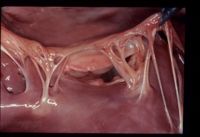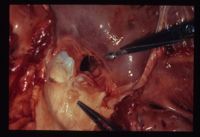Ventricular Septal Defect
Also known as VSD
- Most common congenital cardiac abnormality in large animals
- Second most common congenital cardiac abnormality in cat
- Occurs in dogs
Signalment
Genetics & Predisposed Breeds: Keeshonds, English Springer Spaniel, English Bulldog, West Highland White Terrier
Description
- Ventricular defects are usually in the membranous area of the interventricular septum.
- On the right ventricle, the septal defect usually occurs below the septal leaflet of the tricuspid valve.
- On the left ventricle, the septal defect usually occurs under the aortic valve.
- Ventricular Septal Defects can occur alone or in combination with other congenital malformations.
- Usually blood flows from the higher pressure left ventricle through the shunt to the lower pressure right ventricle. Left to right shunting causes volume overload of the pulmonary circulation and consequently the left atrium and ventricle. The consequences of L-R shunting are left sided congestive heart failure and pulmonary hypertension.
- Shunting can be reversed from L-R towards R-L if pulmonary hypertension increases the pressure on the right side of the heart and/or there is also pulmonic stenosis (Eisenmengers's Physiology). A R-L shunt would allow unoxygenated blood into the systemic circulation resulting in arterial hypoxemia. Increased amounts of blood into the systemic circulation causes an increased right sided pressure load.
Diagnosis
History & Clinical Signs
-Coughing
-Exercise Intolerance
-Left-sided congestive heart failure
-Right-sided heart failure
-Cyanosis (with R-L shunt)
-Asymptomatic (small defects)
Physical Exam
-Holosystolic murmur over left apex and right sternal border (diagonal murmur)
-Systolic murmur over pulmonic valve (pulmonic stenosis)
-Diastolic murmur over aortic valve (aortic regurgitation)
-Murmur from mitral regurgitation (caused by left ventricular dilation)
Radiographic Findings
Normal findings with small defects
Left to Right Ventricular Septal Defect
-Pulmonary overcirculation
-Left-sided heart enlargement
-Signs of left-sided heart failure
-Enlargement of pulmonary artery (if pulmonic stenosis is present)
-Right ventricular enlargement (seen with pulmonary hypertension)
Right to Left Ventricular Septal Defect
-Right-sided heart enlargement
-Normal to enlarged pulmonary artery
Echocardiographic Findings
-Visible defect in the intraventricular septum
Doppler confirms blood shunting through defect
Electrocardiographic (ECG)
-Left sided enlargement (L-R shunt)
-Right ventricular hypertrophy (R-L shunt)
-Arrhythmias
-Wide or notched Q wave showing abnormal septal depolarization
Treatment
Mild/Moderate Cases
-No treatment
-May close on their own
Severe Cases
Medications:
-Drugs to decrease volume through the shunt (arterial vasodilators for R-L shunt)
-Drugs to combat heart failure
Surgery:
-Surgical closure of the septal defect (open heart surgery rarely performed in veterinary patients)
-Pulmonary artery banding (Palliative surgical procedure to decrease left to right shunting)
- Use of vasodilators and the surgical procedures above are contraindicated with a right to left shunt
Prognosis
Mild/Moderate Cases
-Excellent
Severe Cases
-Guarded (L-R shunts)
-Poor (R-L shunts)
From Pathology
Often associated with other conditions E.g. Tetralogy of Fallot.
Usually occur high in the membranous region of the interventricular septum. Blood flows from left to right ventricle during systole resulting in right ventricular overload, increased central venous pressure and pulmonary overcirculation.
Eisenmenger's Syndrome: chronic pulmonary overcirculation results in pulmonary hypertension and increased right-sided pressure. This facilitates right to left shunting and reduced lung perfusion, leading on to cyanosis.
Incidence:
- Not common in dogs but increased incidence in WHWTs and Cocker Spaniels.
- More common in cats and cattle.
Clinical Signs:
- Depend upon size of defect, may include; exercise intolerance, venous congestion etc.
- Harsh holosystolic murmur. Murmur grade correlates inversely with the defect size.
Diagnosis:
- Left and right ventricular hypertrophy, often generalised cardiomegaly on radiology and ECG.
- Pulmonary overcirculation on radiology.
- Left ventricle hyperkinetic on echocardiography and often the defect may be visualised. Doppler echocardiography may be useful.
- Mitral regurgitation is common due to a change in size of the left ventricle and consequent alterations to the Mitral valve.
Treatment:
- Small defects require no treatment.
- Pulmonary Banding protects the pulmonary circulation by restricting its blood flow.
- Symptomatic therapy for left heart failure E.g ACE inhibitors.
- Prognosis variable with defect size.



